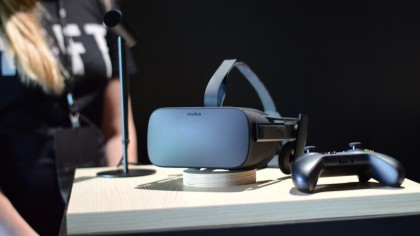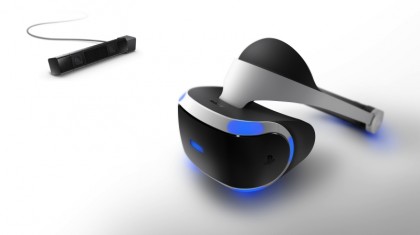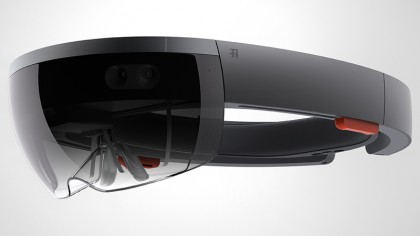The VR race: What you need to know about Oculus Rift, HTC Vive and more
Virtual reality is closer than ever

When it comes to emerging technologies, numerous tech companies appear to be eyeing virtual reality as a veritable New World ripe for plunder. The technology itself, of course, has existed for decades in one form or another; however, it's only been able to offer little more than novel functionality for consumer-facing markets.
But VR tech has evolved dramatically in recent years and the industry is now heating up and heading towards a virtual arms race with 2016 now clearly the year that we'll see the headsets in living rooms.
Companies like Samsung, Sony, Google and Oculus are now all names associated with VR for gaming, social and mobile platforms - and they're all getting closer to bringing their products to market, but how fully realized will the products be?
Microsoft has its own offering evening the playing field with the HoloLens - which focuses on augmented reality, or holograms - leaving us to wonder whether will AR finally secure a place under the spotlight.
Let's take a look at how the virtual competition stacks up so far.
Industry leader: Facebook's Oculus Rift
If smartphone headsets are the toe-in-the-water version of VR, then Oculus is on an Olympic-diving-board level. Remember that duct-taped Oculus Rift prototype with the bulging cable headdress from 2012? That was ages before Facebook bought the tech startup for $2 billion in March, 2014. The company's previous development kit for its flagship VR headset was the industry's leader by a massive margin.
Oculus just held its second Connect conference and while it didn't reveal pricing or an official release date, there was still a lot said about the Rift. Eager consumers were already warned that a heavy duty PC is needed to explore VR with an Oculus Rift. Oculus is releasing PCs that can handle the computing power that's needed called the "Oculus Ready PC Program." In partnership with Nvidia, AMD and Intel, these PCs will be fully stocked and affordable (for a high end machine) with Oculus VP of Product Nate Mitchell promising they'll cost $1000 (about £660, AU$1400) and no higher.
Sign up for breaking news, reviews, opinion, top tech deals, and more.
Thanks to a pre-E3 2015 conference, we know the Oculus Rift will ship with an Xbox One controller and Oculus Touch controllers later on.
Even better, the company has finally revealed the final consumer version of Rift along with the release date of Q1 2016. This aligns with the Project Morpheus's slated launch as well, meaning 2016 is the year we'll finally see VR thrive at home.

Potential Competitive Edge: The Oculus Rift has both a ton of hype and a boatload of name recognition working in its favor. Additionally, creating its own controllers is a welcome change from the company's previously wishy washy responses about peripherals. Partnering with Microsoft to ship with Xbox One controllers is also a smart move for both companies.
The device's substantial backing by Facebook also ensures it's not going to be looking for financial support anytime soon. Now with a the double whammy of a release date and astoundingly immersive Oculus Touch controllers, Oculus seems poised to take the VR crown.
The only problem? You'll need a pretty good PC to play with the Oculus. Aside from the gamer crowd, most people won't have a heavy duty computer, nor will they spend money on one which puts the Rift in a tight spot.
VR dream team: HTC Vive
We thought the HTC Vive would be the first to grace our homes with VR but it looks like only a few people will get their hands on the device. Announced during PAX Prime earlier this year, only a limited quantity is being shipped with the bulk heading out in Q1 of 2016. That's right around the time Oculus Rift and PlayStation VR should be shipping as well.
When the Vive was first revealed, it was a move few saw coming. Valve, creator of popular PC gaming platform Steam, teaming up with mobile company HTC to create a VR headset. Not many have been lucky enough to get their hands on the new VR contender, but those who've seen it, have been floored by its superb graphics and VR immersion. Lately however, it seems like the companies are eager to get more people to use it. The summer road trip recently ended but we're sure it'll be back on more tours soon.
Running the SteamVR platform which has been in beta since January of this year, the Vive is designed to be high-end hardware which brings clearer, crisper images than other VR headsets- and allows for real time 360 movement within the virtual reality landscape.
37 sensors connect to two wireless infrared cameras on the front of the head mounted display, and the head straps are similar to most other HMDs out there. Further specs have yet to be released though the Vive is supposed to hit shelves during the holiday season - which seems ambitious at this point.

Potential Competitive Edge: Just like Sony and Microsoft, Valve and Steam have a diehard following. If anything can push the Oculus Rift off its pedestal, it's the Vive.
Both are PC oriented headsets and tethered but the Vive seems to be more interactive at this point, with goals aligning closer with the Morpheus's. Like Sony's device, the Vive has controllers which brings forth another piece of interaction within the virtual world. Oculus on the other hand seems set on proving it can provide experiences, leaving the peripherals to third parties.
Pricing will be a tricky point for the HTC-Valve love affair. Apparently it will cost an arm and a leg - though most if not all the VR headsets will likely be pricey.
Console gaming and VR: Sony's PlayStation VR
Project Morpheus is no more - well, in name. Revealed during the Tokyo Game Show, Sony is now calling the virtual reality headset PlayStation VR. It makes sense to stay consistent with the PS4 nomenclature, especially since we're expecting some sort of bundle when the headset hits the stores.
Virtual reality for console gamers may not get more in-depth than Sony's formerly named Project Morpheus. Reviewers commented that the product feels "more polished" than other products reportedly close to market, including the Oculus Rift.
GDC 2015 saw the latest iteration of the Morpheus complete with updated specs and a firmer release timeline of "early 2016."
Previously 1080p HD LCD display coupled with a 90-degree field of vision and less LED lights for tracking, the headset now has a larger 5.7-inch OLED screen with 1920 x RGB x 1080 resolution. The field of view has been stretched to 100 degrees, and it now supports an impressive 120fps output (a new SDK will let 60fps images output at 120fps, too).
Like many of these devices in the development phase, a chief concern is the weight of the headset. Wearing heavy VR headsets for longer than 15 minutes ruins the experience with the possibility of sore neck muscles and headaches. The newest PlayStation VR seems to alleviate these issues by lightening the load and configuring various components inside to make it weigh less.

Potential Competitive Edge: Sony has its own movie and television studios, a huge pile of cash and the PS4 to its credit. This means the company can supply much of its own content, and that it has a ready-made legion of loyal gamers at its disposal.
While Sony's initial aspirations for its VR headset seem to be a little more limited in scope than Facebook's, they are no less ambitious. When the project was announced last March (perhaps no coincidence that this was roughly the same time Facebook acquired Oculus), SCE President Shuhei Yoshida went on record to say, "Project Morpheus is the latest example of innovation from SCE, and we're looking forward to its continued development and the games that will be created as development kits get into the hands of content creators."
Promising reports from tech reviews also appear to indicate that there is little downside to the Morpheus at this stage in its development. It would seem that Sony currently is firing on all cylinders with its VR offering.
No longer lagging behind: Microsoft HoloLens
Microsoft also had a tidbit of information to spill about the future of the HoloLens and gaming during GDC 2015. Head of Xbox Phil Spencer led a panel discussing the importance of games on the augmented reality device where he said, "We see this as a full Windows 10 device with holographic capability,"
Spencer added that the HoloLens APIs will be made available with Windows 10 gaming SDK.
The seven year project has been under wraps for a long time though Microsoft is a late-comer to the VR/AR party with its latest offering: the HoloLens. The FOVE was previously on this list as the closest to virtual reality Microsoft ventured into, but it seems like augmented reality is where the company is headed now.
Not much else has been mentioned about the AR device in terms of pricing, but Microsoft is shooting for the same release date as Windows 10 - which is pretty ambitious considering it's been rumored as June 2015.
Aside from giving the HMD a fancy marketing spin - holographic projections opposed to augmented reality, Microsoft invented a third processor: a holographic processing unit or HPU. The HoloLens also includes a CPU and GPU as well. The HoloLens will be wireless, meaning users can move and interact untethered in the world around them as they simultaneously view and interact with projections. It also doesn't need a PC connection or phone to operate making the battery life questionable as it's unknown at this point.
A service called Holo Studios lets HoloLens users create 3D objects, moving and manipulating projected images in space. These creations can then be 3D printed.

Potential Competitive Edge: Like Sony, Microsoft's Xbox One allows for a very clear path to market. And if paired with the console, this headset could make for an incredibly versatile device with a wide range of both gaming and non-gaming applications.
Our hands on with the HoloLens provided a pleasantly surprising experience - one that left skeptics in awe at how well the HMD actually works. It looks like it's past the prototype stage but it still has a long way to go. It doesn't seem likely to launch on time this year considering the device seems pricey to manufacture.
The promising hardware and software coupled with the untethered aspect - if it doesn't suck up all the battery life - could make the HoloLens the biggest achievement for Microsoft in the augmented reality space.
If it fails however, Microsoft will have the security of its virtual reality partnerships with both Valve and Oculus.
- 1
- 2
Current page: The VR race: Valve, Sony, Microsoft and Oculus
Next Page The VR race: Samsung, Google and Razer